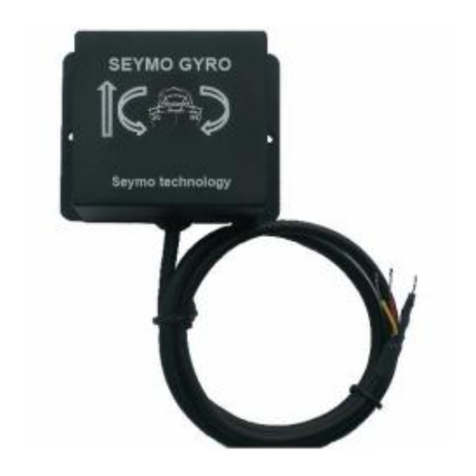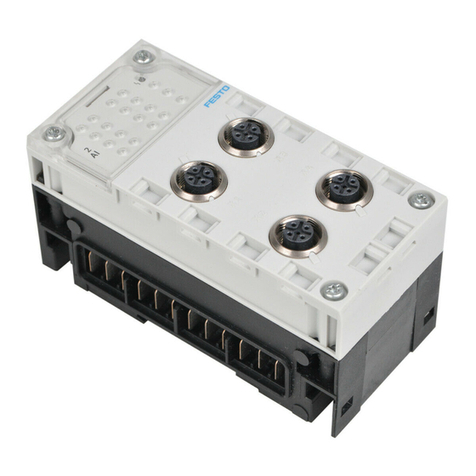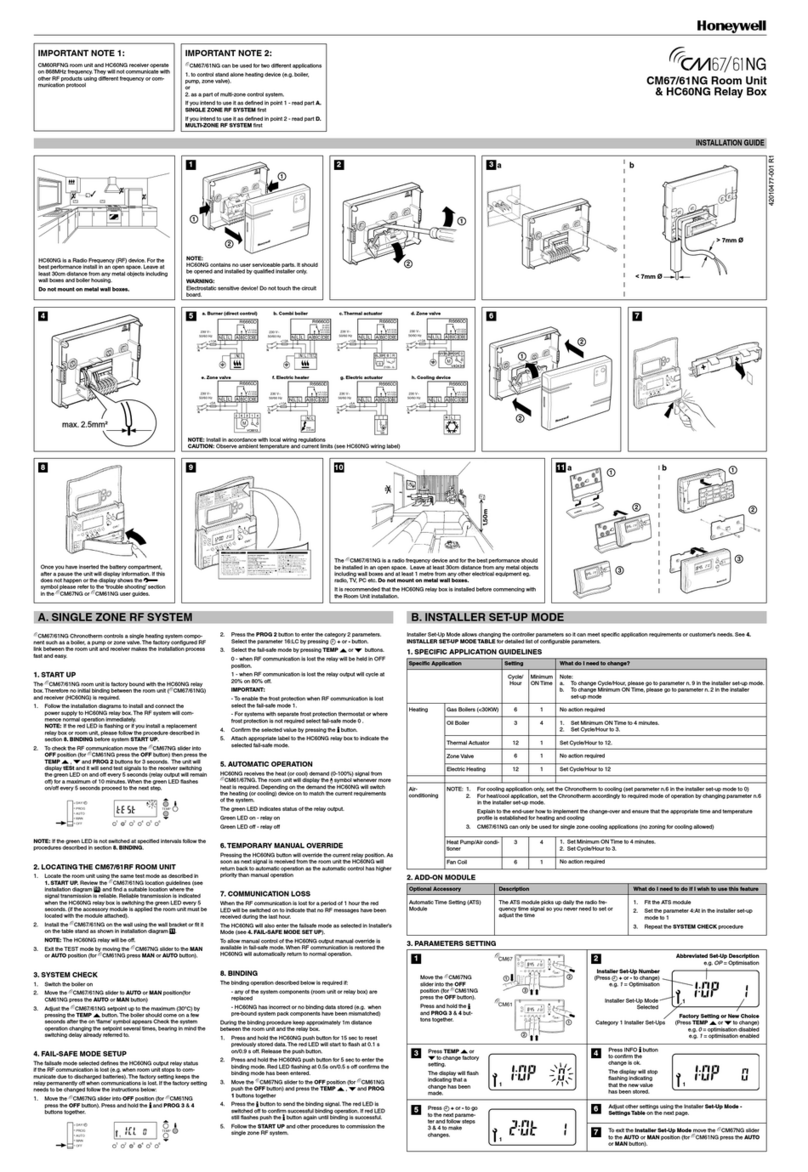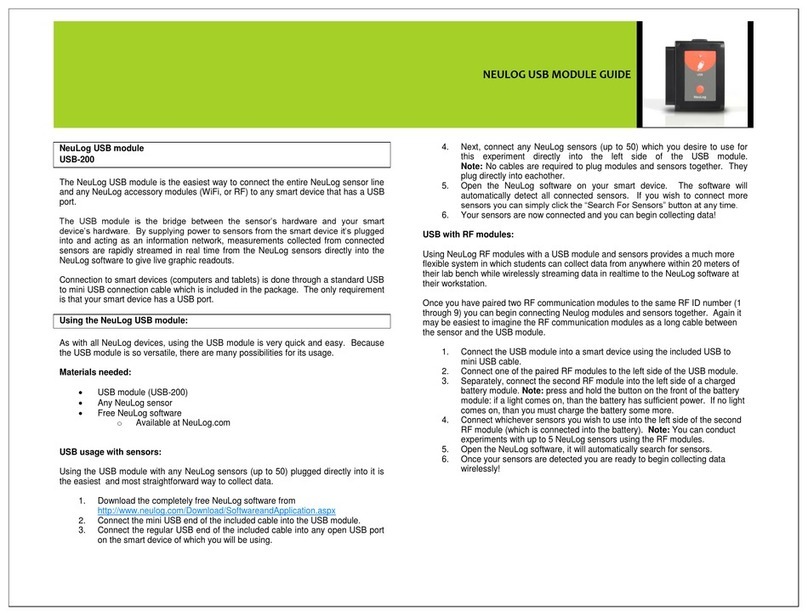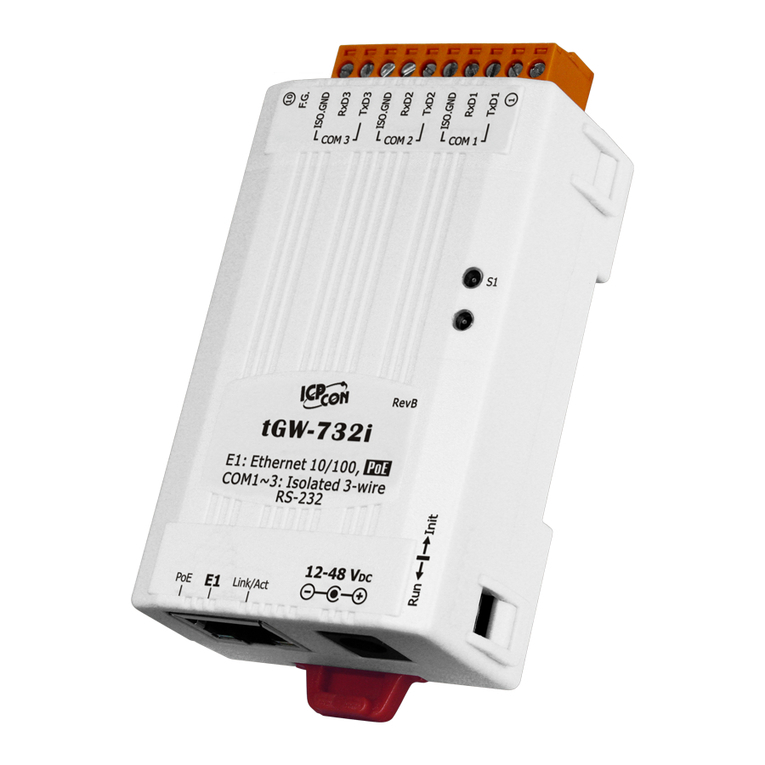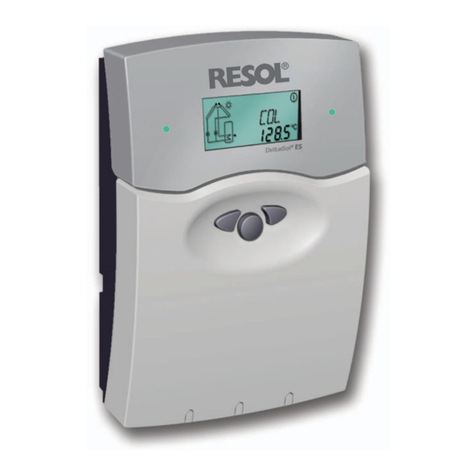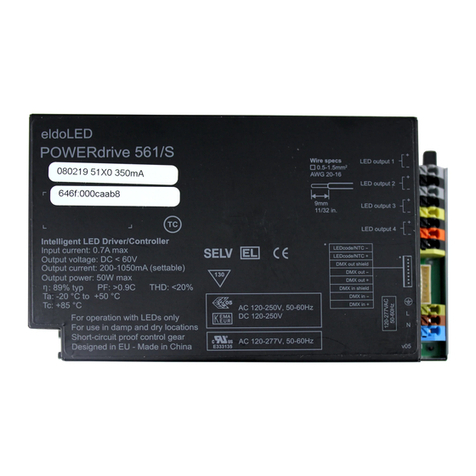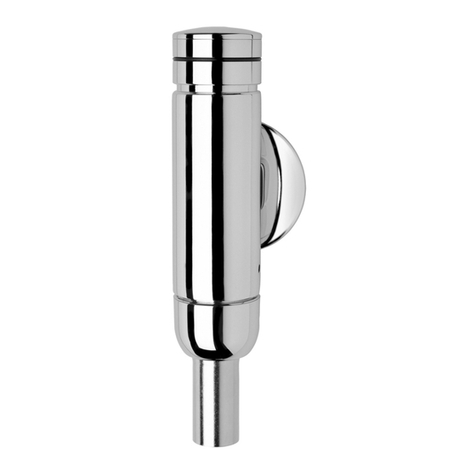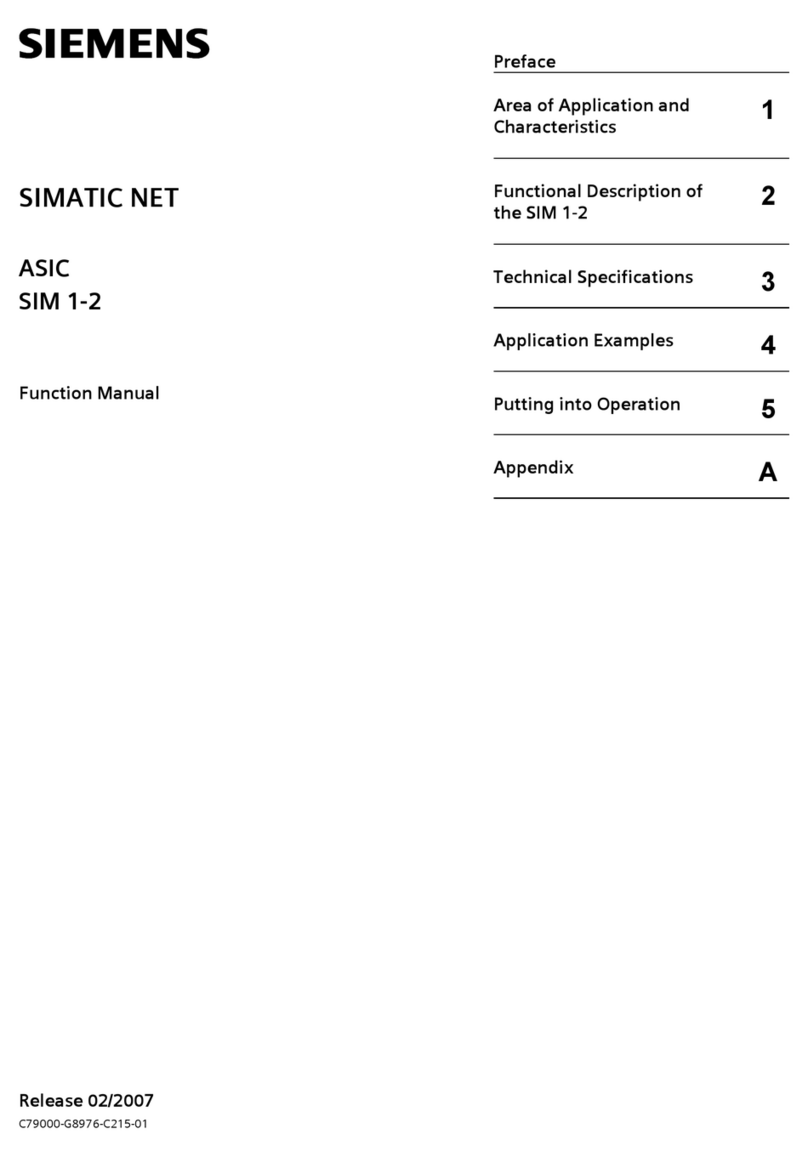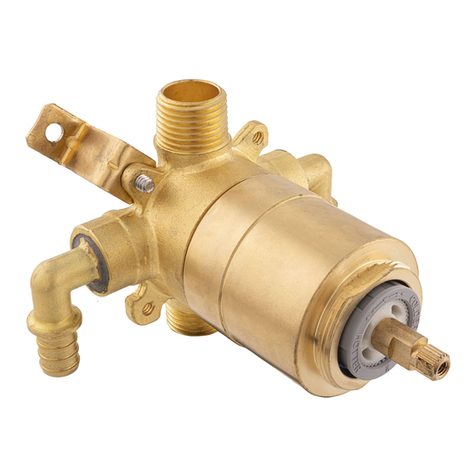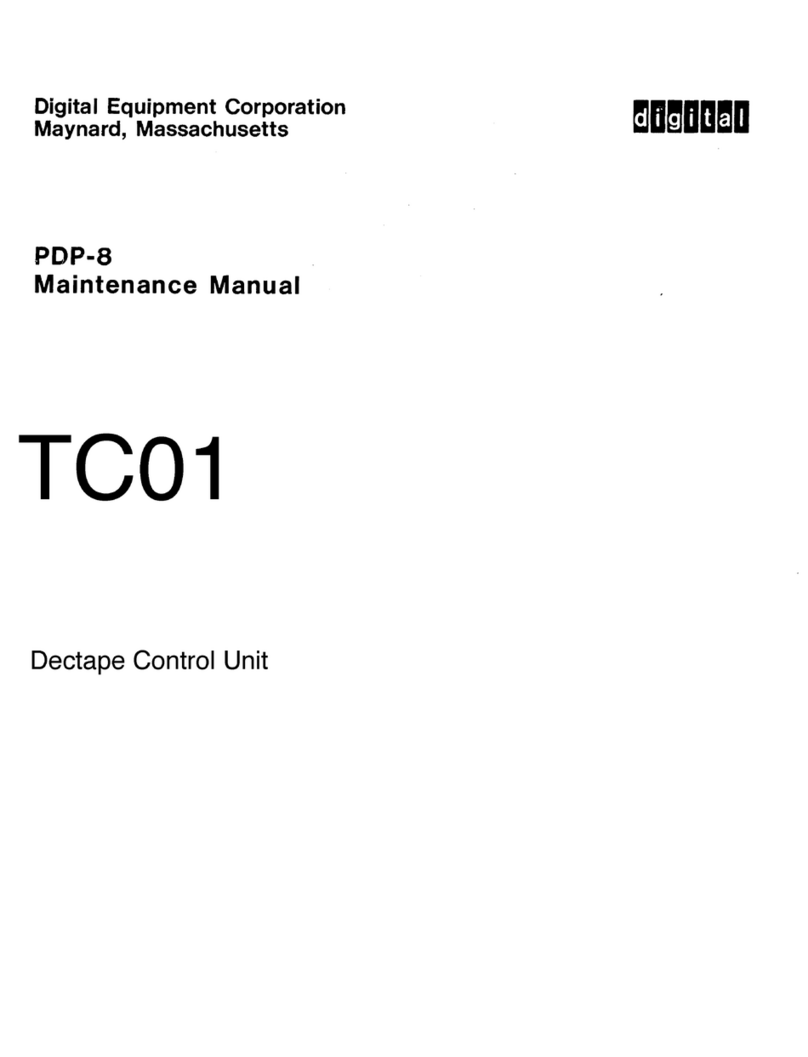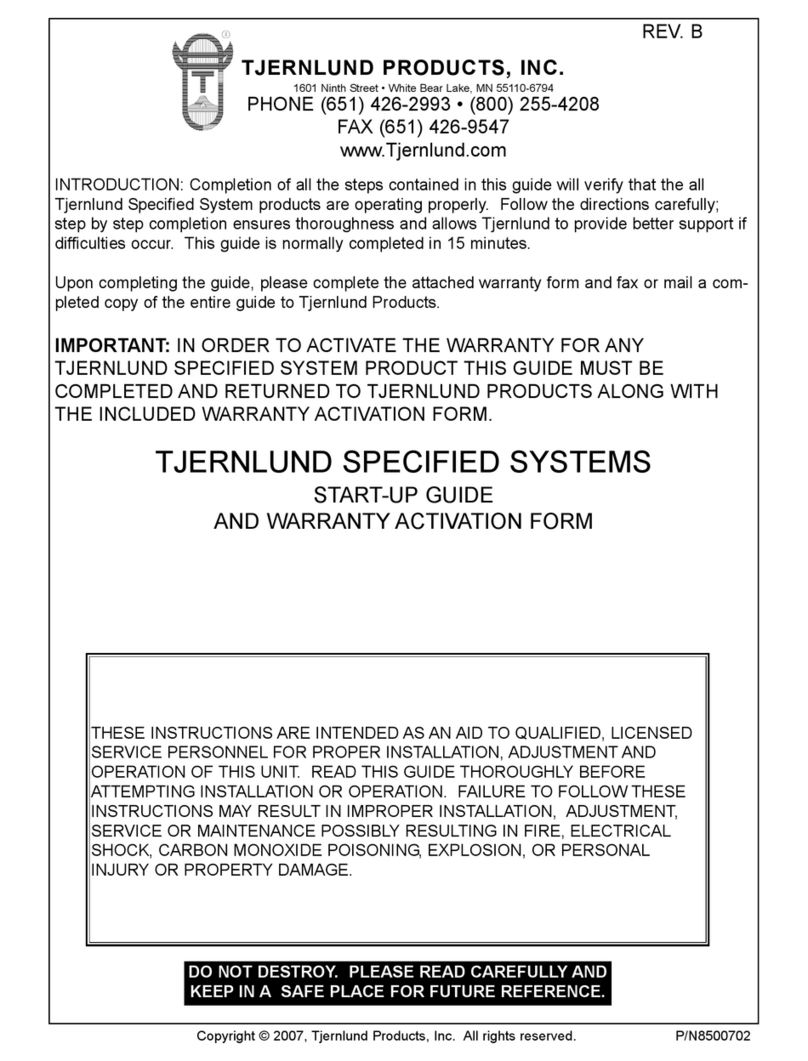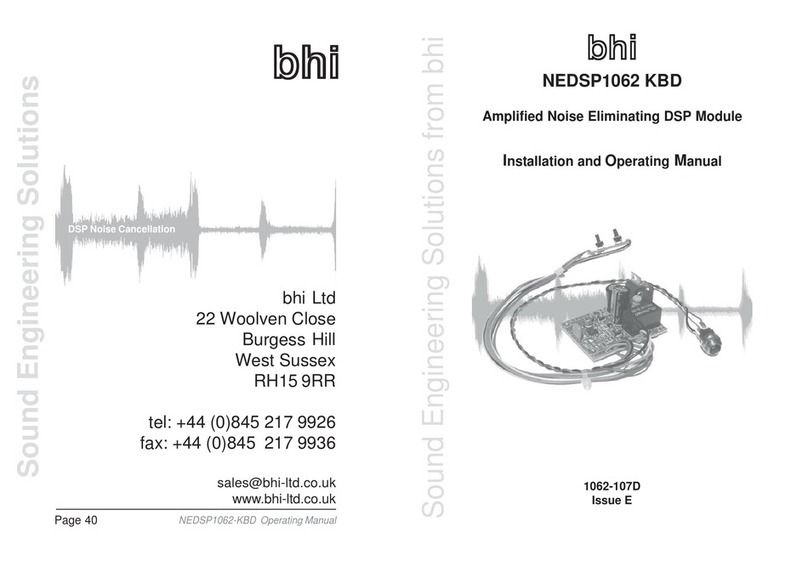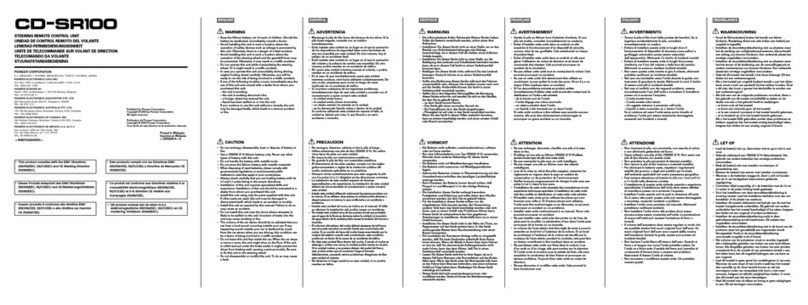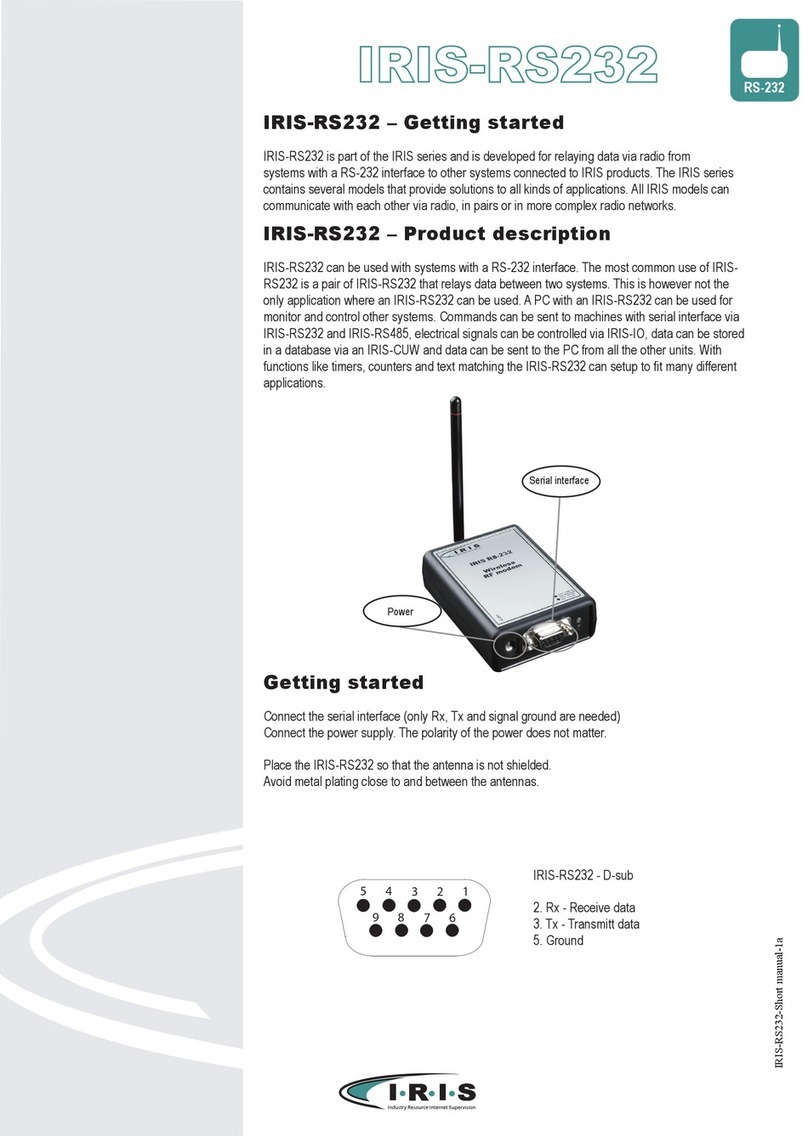GRAF & MEYER eXentro ECU Instruction sheet

eXentro ECU emergency control unit
Safety and Installation Guideline

The manufacturer reserves specification privileges. Information in this manual is subject to change without prior notice or obligation.
English

3
Table of Contents
1. Important Safety Information 4
2. Declaration of Conformity 6
3. Warranty Period 6
4. Service 6
5. Description 7
6. Quick Start Guide to initial setup 8
6.1 Unpacking
6.2 Rack Installation
6.3 Ventilation
6.4 AC/DC Power connection
7. Front & rear indicators and connections 9
7.1 Front panel indicators
7.2 Rear panel connection
8. Technical Specifications 11
9. Expansion cards 12
9.1 eXentro ECU 4x4 card (optional)
9.2 eXentro ECU zone controller card (optional)
9.3 eXentro ECU ETH card (optional)
10. eXentro ECU redundancy modules (optional) 14
11. Emergency panels 14
11.1 eXentro fire panel (FP):
11.2 eXentro evacuation panel (EP)
11.3 eXentro fire alarm system interface (FAS)
11.4 FP/EP/FAS features:
11.5 FP/EP/FAS settings and connections:
11.6 eXentro FP/EP ZE module
11.7 eXentro FAS ZE card
11.8 Emergency panel accessory cards:
11.9 Power consumption
English
12. Hardware system configuration 26
12.1 Cable requirements
12.2 System overview
12.3 Line monitoring & End of Line dummy load:
12.4 eXentro ECU 4x4 card card configuration options:
12.5 Backup amplifier:
12.6 Message storage cards:
12.7 External signal input & Alarm signal output:
12.8 Error input & Alarm/Error output contacts:
12.9 48 Vdc battery backup input:
12.10 Storage of system design and settings:
13. User control and system setup 35
13.1 User control
13.2 System setup
14. Error Messages 36
15. Trouble shooting 38
Appendix A: Amplifier & Loudspeaker 39
line options
Appendix B: Backup amplifier 41
configuration options
Appendix C: End of Line dummy load 43
Appendix D: Loudspeaker lines at 50 V/100 V 44
and cable loss
Appendix E: Emergency panel text labels 45
& requirements
Appendix F: Emergency power supply 46
battery capacity
Appendix G: EN54-16 optional requirements 48
Appendix H: Manufacturing a VACIE / 49
Rack building
Appendix I: Connecting a fire alarm 56
system directly to an eXentro
fire/evacuation panel
Appendix J: Expansion card headers, 58
jumper settings and memory chip
Appendix K: Maintenance 59

1. Important Safety Information
English
4
1. Important Safety Information
This product is intended for installation by professional installers only! This document
is intended to provide professional installers with basic installation and safety guidelines for
the eXentro ECU emergency control unit in typical fixed voice alarm installations. Please read
this document before attempting installation.
Warning: All products must be used in accordance with local, state, federal and industry
regulations. It is the installer’s responsibility to ensure installation of the unit/system
is performed in accordance with all applicable codes, including local building codes and
regulations. Consult the local authority having jurisdiction before installing this product.
Warning: To reduce the risk of fire or electrical shock, do not expose the product to rain
or moisture.
Caution: Do not mount the chassis in locations where condensation may occur.
Warning: Do not expose this apparatus to dripping or splashing, and do not place objects filled
with liquids such as vases, on or near the apparatus. As with any electronic products, use care
not to spill liquids into any part of the system. Liquids can cause a failure and/or a fire hazard.
The lightning flash with arrowhead symbol, within an equilateral triangle, is intended to alert the
user to the presence of uninsulated dangerous voltage within the system enclosure that may be of
sufficient magnitude to constitute a risk of electrical shock. Do not touch the input/output terminals
while the product is ON. Make all connections with the product OFF.
The exclamation point within an equilateral triangle, as marked on the system, is intended to
alert the user to the presence of important operating and maintenance instructions in this
installation guide.
Caution: Make no modifications to the product or accessories. Unauthorized alternations may
compromise safety, regulatory compliance and system performance.
Caution: This product shall be connected to an AC mains socket outlet with a protective
earthing (grounding) connection.
Caution: Do not place any naked flame sources, such as lighted candles, on or near the apparatus.
Warning: Contains small parts which may be a choking hazard. Not suitable for children
under age 3.
Note: Where the mains plug or appliance coupler is used as the disconnect device, such
disconnect device shall remain readily operable.
Note: The product must be used indoors. It is neither designed nor tested for use outdoors, in
recreational vehicles, or on boats.

English
1. Important Safety Information
5
Important Safety Instructions
1. Read these instructions.
2. Keep these instructions – for future reference.
3. Heed all warnings – on the product and in all product documentation.
4. Follow all instructions.
5. Do not use this apparatus near water.
6. Clean only with a dry soft cloth. Don’t use alcohol, ammonia, or other strong solvents/liquids.
7. Do not block any ventilation openings. Install in accordance with the manufacturer’s
instructions. To ensure reliable operation of the product and to protect it from overheating
put the product in a position and location that will not interfere with its proper ventilation.
8. Do not install near any heat sources, such as radiators, heat registers, stoves, or other apparatus
(including amplifiers) that produce heat.
9. Do not defeat the safety purpose of the polarized or grounding-type plug. A polarized plug has
two blades with one wider than the other. A grounding-type plug has two blades and a third
grounding prong. The wider blade or third prong is provided for your safety. If the provided plug
does not fit in your outlet, consult an electrician for replacement of the obsolete outlet.
10. Protect the power cord from being walked on or pinched, particularly at plugs, convenience
receptacles, and the point where they exit from the apparatus.
11. Only use attachments/accessories specified by the manufacturer.
12. Use only with the cart, stand, tripod, bracket, or table specified by the manufacturer
or sold with the apparatus. When a cart is used, use caution when moving the
cart/apparatus combination to avoid injury from tip-over.
13. Unplug this apparatus during lightning storms or when unused for long periods of time to
prevent damage to this product, if allowed by local standards.
14. Refer all servicing to qualified service personnel. Servicing is required when the apparatus has
been damaged in any way such as power-supply cord or plug is damaged; liquid has been spilled
or objects have fallen into the apparatus; the apparatus has been exposed to rain or moisture,
does not operate normally, or has been dropped. Do not attempt to service this product yourself.
Opening or removing covers may expose you to dangerous voltages or other hazards. Please call
your dealer to be referred to an authorized service center near you.
15. To prevent risk of fire or electric shock, avoid overloading wall outlets, extension cords,
or integral convenience receptacles.
16. Do not let objects or liquids enter the product – as they may touch dangerous voltage points
or short-out parts that could result in a fire or electric shock.
17. See product enclosure for safety related markings.
18. No naked flame sources, such as lighted candles, should be placed on the apparatus.
19. The mains plug is used to disconnect the device and it shall remain readily operable.
To completely disconnect the power input, the mains plug of the apparatus shall be
disconnected from the mains and the DC input plug (if applicable) should be disconnected.
20. Do not allow the unit to exceed the maximum operating ambient temperature of 40° C.
Be aware of conditions in an enclosed rack that may increase the temperature above room
ambient conditions.

2. Declaration of Conformity
English
6
2. Declaration of Conformity
The manufacturer of this product declares that this product is in accordance with
the following standards:
EMC Directive 2004/108/EC:
EN55103-1:2009*
EN55103-2:2009
EN61000-3-2:2006/A2:2009
EN61000-3-3:2008
*This Product meets the immunity requirements for E2 class EN55103-1 directive.
Initial turn on inrush current: 0.3 A (230 VAC / 50 Hz).
Inrush current after 5 seconds AC mains interruption: 0.25 A (230 VAC / 50 Hz).
WARNING: This is a class A product. In a domestic environment this product may cause radio
interference in which case the user may be required to take adequate measures.
Low Voltage Directive 2006/95/EC (Safety): EN/IEC60065:2002 (7th edition)
RoHS2 Directive 2011/65/EU of the European Parliament and of the Council of 8 June 2011 on the
restriction of the use of certain hazardous substances in electrical and electronic equipment.
When the eXentro ECU emergency control unit is used in combination with other eXentro Voice
Alarm components, it is in accordance with the following standard:
CPR Construction Products Regulation 305/2011 EU:
EN54-4: 1997 + A1: 2002 + A2: 2005
EN54-16: 2008, see Appendix G for included optional requirements.
IMPORTANT NOTE: above CE label can only be applied to the VACIE (Voice Alarm Control and
Indicating Equipment) of an eXentro Voice Alarm system when the VACIE has been manufactured
using eXentro Voice Alarm components, including a dedicated range of 19" racks and when all
wiring/connections are made as specified by Gräf & Meyer GmbH. Adding other products to the 19"
rack of the VACIE is not allowed and will void the Declaration of Conformity. See appendix H for
more information.
3. Warranty Period
The eXentro ECU emergency control unit comes with a 2-year transferable limited warranty.
4. Service
If you experience problems with your ECU emergency control unit, contact your authorized
dealer. The dealer will verify any defects and arrange for service. Refer to appendix K for
maintenance of the eXentro Voice Alarm system.

English
5. Description
7
5. Description
The eXentro ECU emergency control unit is the main system controller in a voice alarm system,
which monitors all connected low impedance & 50/100 V loudspeaker lines (both A&B lines),
zone & backup amplifiers, emergency paging panels and AC & DC power sources. It includes
pre-recorded messages of which two can be played simultaneously, routed to different outputs.
Any monitored fault will be indicated by the General Error or System Fault indicator on the front
panel and internal buzzer, some by means of additional information indicated on the Graphic
Display, and by multiple Error output relay contacts. Power, System Fault, General Error and
Alarm status are located on the front panel. The system design and settings are stored on a
removable memory chip
Expansion of the 4 outputs zones up to 12 outputs (using 2 expansion cards) in one unit. Up
to 32 ECU units can be used in one voice alarm system to create up to 384 alarm zones, each
with an A and B loudspeaker line. Multiple Fire Panels, EVACuation panels and/or Fire Alarm
System interfaces, expandable up to 196 buttons/inputs, can be connected to meet the
installation/system requirements. The ECU unit can be powered from 230 VAC and from 48 VDC
power supplies when redundant operation is required.
System integrity:
The eXentro Voice Alarm system will detect any fault within 100 seconds and will react on these
accordingly. The system features advanced functionality to maintain operating requirements,
which limits the consequences of faults to ensure maximum audibility and intelligibility of
announcements during emergency situations:
• Monitoring of loudspeaker lines – using adaptive line monitoring to increase the reliability of
the line monitoring, which reduces wrong failure reports e.g. due to temperature changes
• A & B loudspeaker configuration – to maintain audibility of announcements in an alarm zone:
if 1 line fails only a 50% reduction of SPL occurs, while coverage can still be maintained
• Possibility to connect multiple A & B loudspeakers lines per amplifier channel – to increase
overall coverage of large zones
• Monitoring of amplifiers – each amplifier channel is measured independently: if a channel fails
it will be substituted by an available backup amplifier channel
• Multiple backup amplifiers – all 12 outputs of the eXentro ECU unit can be covered by 1 backup
amplifier channel > to increase the integrity of the system up to 3 backup amplifier channels can
be connected to a single eXentro ECU unit covering all 12 zones (1 backup amp for each 4 zones)
• Monitoring of AC mains power supply – each individual system component monitors the AC
mains power supply and has the possibility to switch to 48VDC when its own AC connection
fails
• Emergency power supply – certified according EN54-4: covers the complete system during
AC mains loss, while maintaining output power keeping SPL level(s) unaffected.
• Energy Save Mode – reduces the Idle current consumption of the batteries during an AC mains
loss; saves available battery power capacity which can result in possibly longer duration of
emergency situation at full power. NOTE: refer to local system requirements for minimum
duration required for Idle and Full power operation.
• Monitoring of control inputs – connection to all control inputs are monitored for open line and
short circuits
• Redundant connection (optional) between ECU units & Emergency panels – option to have a
second connection between units which ensures an emergency call can still be made if the
main connection fails
• Multiple inputs to connect emergency panels – inputs are independently monitored, if 1 input
fails an emergency call can still be made on an emergency panel connected to the other input

6. Quick Start Guide to initial setup
English
8
6. Quick Start Guide to initial setup
6.1 Unpacking
While unpacking the eXentro ECU emergency control unit, please inspect the unit. If you find any
damage, notify your supplier immediately. Be sure to save the carton and all packing materials in
case you have to send the product to the supplier. Please use only the original factory packing.
If the shipment carton is unavailable, contact your local dealer to obtain a replacement unit. A
factory packed carton contains:
• eXentro ECU emergency control unit
• IEC-type detachable power cord
• Safety and Installation Guideline
• Connector Accessory Pack
• CD with Installation software and the following manuals required to manufacture a VACIE:
• eXentro ECU Safety and Installation Guide
• eXentro PA Safety and Installation Guide
• eXentro ESP Safety and Installation Guide
6.2 Rack Installation
The eXentro ECU emergency control unit is 2U high and needs to be mounted in
a dedicated 19” rack when used as a component of a Voice Alarm system meeting EN54-16.
Use four fasteners with washers (not supplied) to mount the units front panel rack ears to
the equipment rack rails. Place the ECU on horizontal 19” product carrier rails and make sure a
set of product carrier rails is also mounted above the ECU so the unit can not move (up & down)
on its position. Refer to Appendix H 'Manufacturing a VACIE' for more information.
6.3 Ventilation
The eXentro ECU emergency control unit is designed for continuous operation with ambient
temperatures of up to 40° C. However, to ensure safe operation, the units airflow vents should
never be blocked. Ventilation openings are located at the sides and top of the unit.
6.4 AC/DC Power connection
The eXentro emergency control unit can operate from an AC mains voltage of 230 VAC
(-15%/+10%, 50/60 Hz), or from a DC battery voltage of 48 VDC (-15%/+10%). The presence of the
units internal power supply is indicated by the ‘Power’ LED located on the front panel.
Power Cycle procedure:
To turn the unit ON: first connect the 230VAC and turn the unit ON; after this plug in the 48VDC.
OFF.
Never insert the 48VDC connection when the 230VAC power source is disconnected; always
in a high inrush current at 48VDC which can cause damage to the hardware.

English
7. Front & rear indicators and connections
9
7. Front & rear indicators and connections
7.1 Front panel indicators
1. POWER LED – GREEN: indicates the presence of the internal power supply
2. SYSTEM FAULT LED – YELLOW: indicates a system failure
3. GENERAL ERROR LED – YELLOW: indicates a general error
4. ALARM LED - RED: indicates a Voice Alarm condition
5. Graphic display: use for system setup and system status indication
6. Navigation buttons: use to navigate through all menu items
7.2 Rear panel connection
1. Line inputs 1 to 4, balanced
2. Amplifier inputs 1 to 4 & Loudspeakers outputs 1a/b to 4a/b – NOTE: Pay attention, connections
3. Line outputs 1 to 4 balanced
4. Line output to Backup amplifier, balanced
5. Auxiliary line output, balanced
7. Expansion slot for optional 4x4 card (Zone 5-8)
8. Expansion slot for optional 4x4 card (Zone 9-12)
9. Emergency panel bus 1 – to connect to 1 or more emergency panels (FP/EP/FAS)*
10. Emergency panel bus 2 – to connect to 1 or more emergency panels (FP/EP/FAS)*
11. Unit link out – output to link to next unit (slave)*
12. Unit link in – input link coming from previous unit (master or slave)*
13. USB port – to connect to computer for system setup and/or monitoring
potential free contact closure
5 61 2 3
61 3 42 5
109 1211 1413 15 16 17 18 19 20 21
7 8

7. Front & rear indicators and connections
English
10
15. Alarm output – Provides Alarm signal & potential free contact closure during
emergency situation
16. Ethernet connection – requires optional ETH card: using LAN connection, to setup
and/or monitor the system
17. Expansion slot for optional zone controller card (behind this cover plate the message cards
and system update connector are located)
• Mains Error – to connect to the PA amplifiers, C48 mains power error contact and optional
circuit breaker fault contact
• External Error – to receive error information from external system(s)
• C48 Error – to receive error information about the 48 VDC input and output connection
of the C48 Charger
19. Output relay contacts potential free, normally open from left to right:
• GPO – closed when AC power fails and no emergency signal is running and
no line monitoring is activated
• System Fault - closed when a system failure (MCU/Data storage) is found in the system
• Error 1 (General) - closed when an error is found in the system
(an internal jumper can be set to change to a normally closed contact)
• Error 2 (General) - closed when an error is found in the system,
also when the eXentro ECU is de-energized.
• PSU Fail – closed during a 230 VAC failure
20. 48 VDC input, powered from Charger C48
21. 230 VAC input, switch and mains fuse
*NOTE: the Emergency panel bus 1 & 2 have a fixed 120 ohm termination for the communication
bus. When multiple emergency panels are connected to these ports in daisy chain, make sure
that termination is only placed inside the last emergency panel to each of these lines. The
unit link in & out have a 120 ohm termination for the communication interlink, make sure that
termination is set only at the first and last unit in the system. See appendix J. for the 120 ohm
termination jumper location.

English
8. Technical Specifications
11
*NOTE: These specifications are applicable for all system components used in the eXentro
Make sure to have an average temperature of about 20 degrees C. in the technical room.
**NOTE: Max power consumption is measured with the maximum number of 4x4 cards installed
and maximum number of emergency panels connected.
8. Technical Specifications
Line Inputs (4 zone card) 4x Audio: 0 dB, balanced. Range: -90 to +6 dB
Line Outputs (4 zone card) 4x Audio, 1x Auxiliary, 1x Backup amp: 0 dB, balanced. Range: -90 to +6 dB
Amplifier inputs (4 zone card) 4x Zone amplifier / 1x Backup amplifier
Loudspeaker A/B outputs (4 zone card) Each output (sum of A+B): 100 V/8 A max, minimum monitored load:
30 Watt @ 100 V
Microphone Inputs 2x Audio: 0 dB, balanced. Range: -90 to +6 dB (for emergency microphones)
External audio input 0 dB, balanced. Range: -90 to +6 dB
Alarm signal output 0 dB, balanced. Range: -90 to +6 dB
Emergency panel bus 1 & 2 48 Vdc / 500 mA max.(total available current for both connections)
THD <0.2% (from line input to line output) / <0.2% (from emergency panel input
to line output)
Frequency response (0, -3 dB) 20 Hz - 18 kHz
Signal to Noise ratio > 85 dB
Operating voltage 230 Vac (-15%/+10%) 50/60 Hz & 48 Vdc (-15%/+10%)
Maximum Inrush Current (230 Vac / 50 Hz) 0.3 A
AC Fuse (in AC mains entry) 0.5 A slow (2x), size: 5x20 mm
AC Fuse 'F1', secondary (on mother board) 2 A slow, size: 5x20 mm
DC Fuse 'F2' (on mother board) 0.5 A slow, size: 5x20 mm
Max Power consumption** 50 W (@ 230 Vac) / 1.5 A (@ 48 Vdc)
Idle power consumption 50 W (@ 230 Vac) / 1.0 A (@ 48 Vdc)
AC Heat Loss (in BTU/h) Max.: 165
DC Heat Loss (in BTU/h) Max.: 165
Dimensions (WxHxD) 482x88x350 (mm)
Weight (max) 2.5 kg
Operating temperature* 0 to 40 degrees C.
Humidity* 93% max.
Air pressure* 86 kPa to 106 kPa

9. Expansion cards
English
12
9. Expansion cards
*NOTE: to install an expansion card, the unit needs to be opened. Make sure to first turn off
9.1 eXentro ECU 4x4 card (optional)
Used to expand an ECU unit with 4 audio/alarm zones, auxiliary output and 1 back up amplifier
(optional). Up to two 4x4 cards can be added to a single ECU unit. The auxiliary output can be
linked to any of the 4 outputs. This output will not be monitored, but will be muted during an
eVACuation. As an example: this output can be used to drive a separate speaker system, or a
subwoofer used in addition to the installed emergency loudspeakers.
Technical specifications:
To install a 4x4 card: turn the power off, remove the top cover and the appropriate blind plate at
the back of the ECU unit. Take care during installation of the card: the pin headers on the card and
on the main board are fragile and bend easily – make sure these are all straight before inserting
the card. Fix the card to the main board with 4 screws. Turn ON the power of the ECU (before the
top cover is placed back): a green LED on the 4x4 card will illuminate, (brightly/'high intensity')
which indicates the card is installed correctly; if this LED does not illuminate or illuminates with
low intensity, quickly turn OFF the power > the card is not installed correctly; the side pin header
may not be installed properly. In case the green LED illuminates brightly, but no audio is coming
from the outputs, 1 of the 2 front row headers is not installed correctly. Carefully remove the card
again to ensure all pin headers are still ok, after that re-install the card and ensure the green LED is
illuminated brightly and audio is coming from the outputs, before the top cover is placed back.See
Appendix A & B for amplifier & backup amplifier connections and Appendix J for more information
on the expansion card headers.
9.2 eXentro ECU zone controller card (optional)
The zone controller card allows control of audio inputs 1-4 (only), which can be routed to output
9.2 eXentro ECU zone controller card (optional)
The zone controller card allows control of audio inputs 1-4 (only), which can be routed to output
Line Inputs 4x Audio : 0 dB, balanced. Range: -90 to +6 dB
Line Outputs 4x Audio, 1x Auxiliary, 1x Backup amp : 0 dB, balanced. Range: -90 to +6 dB
Amplifier inputs 4x Zone amplifier / 1x Backup amplifier
Loudspeaker A/B outputs Each output (sum of A+B): 100 V/8 A max, minimum monitored load: 30 Watt @ 100 V

English
9. Expansion cards
13
1-4 (only), including volume control. Up to 4 Bose CC-4 wall controllers can be connected. This
card does not influence the emergency paging routing. Each ECU can be expanded with
1 zone controller card.
Make sure to carefully install the zone controller card and the small back plate at the back
for more information on the expansion card headers.
Pin layout for controller input 1 – 4:
Wiring diagram to connect a Bose CC-4 wall controller:
Wiring diagram for external potentiometer and switches (potential free):
When the zone controller card and wall controller(s) have been installed, the ECU unit will
automatically detect connected controllers (after calibration routine): if found the ECU will
enable source routing and volume control for a specific zone (example: a detected controller
connected to input 1 allows control of volume and source selection for output 1).
mainboard
680
3K3
VCA Voltage control
COM COM
A Select input 1
B Select input 2
C Select input 3
D Select input 4
Controller
VCA
COM
A
B
C
D
ECU controller connector
A
VOL
COM
B
C
D
CC-4 connector
VCA
COM
A
B
C
D
ECU controller A connector
10kohm Liniar
Mic +
Mic -
GND
DC power (12-48 Vdc)
485 + (A)
485 - (B)
Sys.GND
Shield
GND
B1: Input 1
B2: Input 2
B3: Input 3
B4: Input 4
B5: Input 5
B6: Input 6
GND
GND
B7: Input 7
B8: Input 8
B9: Input 9
B10: Input 10
B11: Input 11
B12: Input 12
GND
5V
L1: Output 1
L2: Output 2
L3: Output 3
L4: Output 4
L5: Output 5
L6: Output 6
5V
5V
L7: Output 7
L8: Output 8
L9: Output 9
L10: Output 10
L11: Output 11
L12: Output 12
5V
GRB: Button B
GRA: Button A
5V
All: All Zones
5V
RES: Reset Evacuation
EVA: Start Evacuation
Mic: Microphone
Dis: Panel Disabled
ALA: Alarm
Err: Error
5V
48V: 48VDC
230V: 230VAC
GRD: Button D
GRC: Button C
GND
Reset buzzer
Lamp test
GND
Button D
Button C
Button B
Button A
GND
All zones
GND
Reset evacuation
Start evacuation
Microphone
Alarm relay NC
Alarm relay COM
Alarm relay NO
Error relay NC
Error relay COM
Error relay NO
Error relay NO*
Error relay COM*
Alarm relay COM
Alarm relay NO
VCA
12 zone buttons
Microphone +
Microphone -
GND
Mic PTT input
Common
R6: Input 6
R5: Input 5
R4: Input 4
R3: Input 3
R2: Input 2
R1: Input 1
Common
24V input relais card
Common
R7: Input 7
R8: Input 8
R9: Input 9
R10: Input 10
R11: Input 11
R12: Input 12
Common
Common
R6: not used
R5: not used
R4: Button D
R3: Button C
R2: Button B
R1: Button A
Common
Common
R7: Button ALL ZONES
R8: Button Start/reset Alarm
R9: Button Pause Alarm
R10: not used
R11: not used
R12: not used
Common
R1: Output 1 Com
R1: Output 1 NO
R2: Output 2 Com
R2: Output 2 NO
R3: Output 3 Com
R3: Output 3 NO
relais card
R4: Output 4 Com
R4: Output 4 NO
R5: Output 5 Com
R5: Output 5 NO
R6: Output 6 Com
R6: Output 6 NO
R7: Output 7 Com
R7: Output 7 NO
R8: Output 8 Com
R8: Output 8 NO
R9: Output 9 Com
R9: Output 9 NO
R10: Output 10 Com
R10: Output 10 NO
R11: Output 11 Com
R11: Output 11 NO
R12: Output 12 Com
R12: Output 12 NO
R1: Microphone Com
R1: Microphone NO
R2: Start/reset Alarm Com
R2: Start/reset Alarm NO
R3: Pause Alarm Com
R3: Pause Alarm NO
R4: ALL ZONES Com
R4: ALL ZONES NO
R5: Button A Com
R5: Button A NO
R6: Button B Com
R6: Button B NO
R7: Button C Com
R7: Button C NO
R8: Button D Com
R8: Button D NO
R9: 230 Vac Com
R9: 230 Vac NO
R10: 48 Vdc Com
R10: 48 Vdc NO
R11: Disable Panel Com
R11: Disable Panel NO
R12: ERROR Com
R12: ERROR NO
mainboard
680
3K3
VCA Voltage control
COM COM
A Select input 1
B Select input 2
C Select input 3
D Select input 4
Controller
VCA
COM
A
B
C
D
ECU controller connector
A
VOL
COM
B
C
D
CC-4 connector
VCA
COM
A
B
C
D
ECU controller A connector
10kohm Liniar
Mic +
Mic -
GND
DC power (12-48 Vdc)
485 + (A)
485 - (B)
Sys.GND
Shield
GND
B1: Input 1
B2: Input 2
B3: Input 3
B4: Input 4
B5: Input 5
B6: Input 6
GND
GND
B7: Input 7
B8: Input 8
B9: Input 9
B10: Input 10
B11: Input 11
B12: Input 12
GND
5V
L1: Output 1
L2: Output 2
L3: Output 3
L4: Output 4
L5: Output 5
L6: Output 6
5V
5V
L7: Output 7
L8: Output 8
L9: Output 9
L10: Output 10
L11: Output 11
L12: Output 12
5V
GRB: Button B
GRA: Button A
5V
All: All Zones
5V
RES: Reset Evacuation
EVA: Start Evacuation
Mic: Microphone
Dis: Panel Disabled
ALA: Alarm
Err: Error
5V
48V: 48VDC
230V: 230VAC
GRD: Button D
GRC: Button C
GND
Reset buzzer
Lamp test
GND
Button D
Button C
Button B
Button A
GND
All zones
GND
Reset evacuation
Start evacuation
Microphone
Alarm relay NC
Alarm relay COM
Alarm relay NO
Error relay NC
Error relay COM
Error relay NO
Error relay NO*
Error relay COM*
Alarm relay COM
Alarm relay NO
VCA
12 zone buttons
Microphone +
Microphone -
GND
Mic PTT input
Common
R6: Input 6
R5: Input 5
R4: Input 4
R3: Input 3
R2: Input 2
R1: Input 1
Common
24V input relais card
Common
R7: Input 7
R8: Input 8
R9: Input 9
R10: Input 10
R11: Input 11
R12: Input 12
Common
Common
R6: not used
R5: not used
R4: Button D
R3: Button C
R2: Button B
R1: Button A
Common
Common
R7: Button ALL ZONES
R8: Button Start/reset Alarm
R9: Button Pause Alarm
R10: not used
R11: not used
R12: not used
Common
R1: Output 1 Com
R1: Output 1 NO
R2: Output 2 Com
R2: Output 2 NO
R3: Output 3 Com
R3: Output 3 NO
relais card
R4: Output 4 Com
R4: Output 4 NO
R5: Output 5 Com
R5: Output 5 NO
R6: Output 6 Com
R6: Output 6 NO
R7: Output 7 Com
R7: Output 7 NO
R8: Output 8 Com
R8: Output 8 NO
R9: Output 9 Com
R9: Output 9 NO
R10: Output 10 Com
R10: Output 10 NO
R11: Output 11 Com
R11: Output 11 NO
R12: Output 12 Com
R12: Output 12 NO
R1: Microphone Com
R1: Microphone NO
R2: Start/reset Alarm Com
R2: Start/reset Alarm NO
R3: Pause Alarm Com
R3: Pause Alarm NO
R4: ALL ZONES Com
R4: ALL ZONES NO
R5: Button A Com
R5: Button A NO
R6: Button B Com
R6: Button B NO
R7: Button C Com
R7: Button C NO
R8: Button D Com
R8: Button D NO
R9: 230 Vac Com
R9: 230 Vac NO
R10: 48 Vdc Com
R10: 48 Vdc NO
R11: Disable Panel Com
R11: Disable Panel NO
R12: ERROR Com
R12: ERROR NO
mainboard
680
3K3
VCA Voltage control
COM COM
A Select input 1
B Select input 2
C Select input 3
D Select input 4
Controller
VCA
COM
A
B
C
D
ECU controller connector
A
VOL
COM
B
C
D
CC-4 connector
VCA
COM
A
B
C
D
ECU controller A connector
10kohm Liniar
Mic +
Mic -
GND
DC power (12-48 Vdc)
485 + (A)
485 - (B)
Sys.GND
Shield
GND
B1: Input 1
B2: Input 2
B3: Input 3
B4: Input 4
B5: Input 5
B6: Input 6
GND
GND
B7: Input 7
B8: Input 8
B9: Input 9
B10: Input 10
B11: Input 11
B12: Input 12
GND
5V
L1: Output 1
L2: Output 2
L3: Output 3
L4: Output 4
L5: Output 5
L6: Output 6
5V
5V
L7: Output 7
L8: Output 8
L9: Output 9
L10: Output 10
L11: Output 11
L12: Output 12
5V
GRB: Button B
GRA: Button A
5V
All: All Zones
5V
RES: Reset Evacuation
EVA: Start Evacuation
Mic: Microphone
Dis: Panel Disabled
ALA: Alarm
Err: Error
5V
48V: 48VDC
230V: 230VAC
GRD: Button D
GRC: Button C
GND
Reset buzzer
Lamp test
GND
Button D
Button C
Button B
Button A
GND
All zones
GND
Reset evacuation
Start evacuation
Microphone
Alarm relay NC
Alarm relay COM
Alarm relay NO
Error relay NC
Error relay COM
Error relay NO
Error relay NO*
Error relay COM*
Alarm relay COM
Alarm relay NO
VCA
12 zone buttons
Microphone +
Microphone -
GND
Mic PTT input
Common
R6: Input 6
R5: Input 5
R4: Input 4
R3: Input 3
R2: Input 2
R1: Input 1
Common
24V input relais card
Common
R7: Input 7
R8: Input 8
R9: Input 9
R10: Input 10
R11: Input 11
R12: Input 12
Common
Common
R6: not used
R5: not used
R4: Button D
R3: Button C
R2: Button B
R1: Button A
Common
Common
R7: Button ALL ZONES
R8: Button Start/reset Alarm
R9: Button Pause Alarm
R10: not used
R11: not used
R12: not used
Common
R1: Output 1 Com
R1: Output 1 NO
R2: Output 2 Com
R2: Output 2 NO
R3: Output 3 Com
R3: Output 3 NO
relais card
R4: Output 4 Com
R4: Output 4 NO
R5: Output 5 Com
R5: Output 5 NO
R6: Output 6 Com
R6: Output 6 NO
R7: Output 7 Com
R7: Output 7 NO
R8: Output 8 Com
R8: Output 8 NO
R9: Output 9 Com
R9: Output 9 NO
R10: Output 10 Com
R10: Output 10 NO
R11: Output 11 Com
R11: Output 11 NO
R12: Output 12 Com
R12: Output 12 NO
R1: Microphone Com
R1: Microphone NO
R2: Start/reset Alarm Com
R2: Start/reset Alarm NO
R3: Pause Alarm Com
R3: Pause Alarm NO
R4: ALL ZONES Com
R4: ALL ZONES NO
R5: Button A Com
R5: Button A NO
R6: Button B Com
R6: Button B NO
R7: Button C Com
R7: Button C NO
R8: Button D Com
R8: Button D NO
R9: 230 Vac Com
R9: 230 Vac NO
R10: 48 Vdc Com
R10: 48 Vdc NO
R11: Disable Panel Com
R11: Disable Panel NO
R12: ERROR Com
R12: ERROR NO

English
14
10. eXentro ECU redundancy modules (optional)
9.3 eXentro ECU ETH card (optional)
Instead of using the USB port, one can connect to the ECU unit using a Lan connection
which can be used to setup the system during installation mode or for monitoring purposes.
The ECU can be expanded with 1 ETH card.
Technical specifications:
See Appendix J for more information on the expansion card headers.
NOTE: When ETH card is installed a green LED, next to the Ethernet/RJ45 connector, is blinking.
This RJ45 connector is pre-mounted in each ECU unit and without ETH card installed this
connector has no function.
10. eXentro ECU redundancy modules (optional)
Can be used for redundant connection between two main units, using Cat5e/6 cabling. If the 1st
Cable (Line A) fails, these modules switch to the 2nd cable (Line B), so communication between
2 units is maintained. A set of these modules is needed between every 2 units in the system.
Refer to the redundancy module installation guide for more information & connection instructions.
11. Emergency panels
All emergency panels are connected to 1 of the 2 emergency panel busses on the ECU unit (Master
or Slave). Each bus provides power to the connected panels. When multiple panels are connected,
it is possible to power each panel separately by connecting to the systems battery charger
directly. Up to 32 emergency panels can be connected to the 2 panel busses of an ECU unit. An
activated emergency panel or emergency signal input will override music playing in the selected
outputs. Priority of a panel is determined by the panel type setting and its communication
address, see chapter 11.5 for more information about priority handling & settings.
NOTE: when connecting multiple emergency panels to bus 1 & 2, please take the maximum
current (500 mA) into account. See also chapter on power consumption of emergency panels
and expansion cards.
Master module Slave module
Inputs RJ45 – cat 5 input
Network speed 10/100MBit Full/Half Duplex
Protocol TCP/DHCP
Unit A Unit B
Line B
Line A

English
11. Emergency panels
15
11.1 eXentro Fire Panel (FP):
The Fire Panel is used to manually activate emergency announcements using a microphone or pre-
recorded messages. With its highest priority in the system (when connected to the Master ECU unit)
it will override any emergency message generated by any other EVACuation panel, Fire Alarm System
interface or External Audio input. It allows to select (groups) of zones using the ABCD buttons. These
ABCD buttons can also be programmed for additional message selection. System errors, alarm, power
supply (AC & DC) and panel status will be indicated using LEDs. The Fire Panel is housed in a closed
enclosure and can be located near the fire man’s entrance of a building. If required it can be extended
with an eXentro FP/EP ZE module, which allows selection of more (groups of) zones. Optional
accessory
cards like 24 VDC input control, relay contact outputs & GPO control are available.
1. Status indicators:
• 230 VAC – green LED indicates presence of 230 VAC
• 48 VDC – green LED indicates presence of 48 VDC
• ALARM – red LED to indicate an activated emergency message
• ERROR – yellow LED & buzzer to indicate an error in the system
• Panel disabled – yellow LED indicates 'user disabled' when ON.
Requires key combination to enable.
IMPORTANT NOTE: If the Panel disabled indicator is 'flashing' while the ERROR indicator &
Buzzer are activated, this indicates that the communication between the eXentro ECU and the
2. Buttons:
• Reset Buzzer
• Lamp test
• Pause Alarm (incl. red LED indicator)
• Microphone (incl. red LED indicator)
• Start/reset Alarm (incl. red LED indicator)
• ALL ZONES (incl. red LED indicator)
• 4x Group/message ABCD button (incl. red LED indicator) – see below for more details
Text cards: the text cards behind the front foil can be removed and replaced with custom
text cards. See appendix C for more info.
Fire panel including a ZE module.
Hand-held microphone talking distance: 10 cm.
10 cm
1
2

11. Emergency panels
English
16
11.2 eXentro eVACuation panel (EP)
The eVACuation panel can used to manually activate emergency announcements using a microphone
or pre-recorded messages. It has the 2nd highest priority in the system and will override any
emergency message from the external signal input or messages activated by the Fire Alarm
System interface. It allows to select (groups) of zones using the ABCD buttons. These ABCD buttons
can also be programmed for additional message selection. System errors, alarm, power supply (AC
& DC) and panel status will be indicated using LEDs. The eVACuation panel is housed in a desktop
enclosure. If required one eXentro FP/EP ZE module can be used to expand the eVACuation panel. For
more zone buttons or 19” rack mount an optional larger housing is available which can house the main
panel and up to 4 ZE modules (or up to 6 ZE modules only). Optional accessory cards like 24 VDC input
control, relay contact outputs & GPO control are available.
1. Status indicators:
• 230 VAC – green LED indicates presence of 230 VAC
• 48 VDC – green LED indicates presence of 48 VDC
• ALARM – red LED to indicate an activated emergency message
• ERROR – yellow LED & buzzer to indicate an error in the system
• Panel disabled – yellow LED indicates 'user disabled' when ON.
Requires key combination to enable.
IMPORTANT NOTE: If the Panel disabled indicator is 'flashing' while the ERROR indicator &
Buzzer are activated, this indicates that the communication between the eXentro ECU and the
2. Buttons:
• Reset Buzzer
• Lamp test
• Pause Alarm (incl. red LED indicator)
• Microphone (incl. red LED indicator)
• Start/reset Alarm (incl. red LED indicator)
• ALL ZONES (incl. red LED indicator)
• 4x Group/message ABCD buttons (incl. red led indicator)
Text cards: the text cards behind the front foil can be removed and replaced with
custom text cards. See appendix C for more info.
25 cm
Evacuation panel including a ZE card.
Gooseneck microphone talking distance: 25 cm.
1
2

English
11. Emergency panels
17
11.3 eXentro fire alarm system interface (FAS)
The FAS has the lowest priority of the emergency panels in the system and is located inside or
with the emergency control unit and emergency messages are activated and routed to the
pre-programmed outputs. The FAS can be expanded with an eXentro FAS ZE card. For more inputs
an optional larger enclosure is available. Optional accessory cards like 24 VDC input control, relay
contact outputs & GPO control are available.
Fire Alarm System interface
Status outputs:
• 230 VAC (output to power LED + resistor)
• 48 VDC (output to power LED + resistor)
• ALARM (output to power LED + resistor and potential free contact closure)
• ERROR (output to power LED + resistor and potential free contact closure)
• Panel disabled (output to power LED + resistor)
Contact closure inputs (potential free):
• Reset Buzzer
• Lamp test
• Pause Alarm (incl. led driver output)
• Microphone (incl. led driver output)
• Start/reset Alarm (incl. led driver output)
• ALL ZONES (incl. led driver output)
• 4x Group/message ABCD (incl. led driver output)
The FAS can also be used to create a custom EVACuation Panel. Make sure to change the ‘Panel
type’ setting (dipswitch 1-3) to FP or EP depending on the required priority and functionality.
NOTE: a switch on the internal pcb of the FAS module allows to ‘reset’ a running eVACuation
started by the Fire Alarm system.
11.4 FP/EP/FAS features:
11.4.1. Group/message ABCD buttons/inputs: can be programmed to select a combination
of outputs, or to select pre-recorded messages (for example a pre-alert/coded or commercial
message). When a group of outputs is programmed for 1 of these buttons (contact closure
inputs for the FAS), this combination is used for all panels of the same type in the system
(example: if button A for the Fire Panel is routed, the ‘A’ button on ALL Fire Panels is using the
same routing table, while button A on an EVACuation Panel can have a different routing table
or can be used for message selection). When a button is used to select a message, this can be
done for each type of panel in the system independently (example: button B on all EVACuation
Panels selects message 4, while button B on all Fire Panels selects message 3 and input B on the
FAS select its routing table). It also features to select 2 messages to be played at the same time
(when these messages are played, the routing will be according to the programmed Alarm/Alert
routing table for each of the zone buttons in the system).
11.4.2. Enable/Disable ABCD buttons: this feature allows enabling or disabling the use of these

11. Emergency panels
English
18
4 buttons for each used panel in the system independently.
Note: If for example button ‘B’ is disabled, this button cannot be used anymore to enter the
sure to set the right code for the ‘Panel Enable’ code. If more buttons need to be disabled, the
the FP, EP and FAS.
11.4.3. Panel enabled/disabled (FP/EP): During normal system operation, all emergency panel(s)
are disabled (yellow led ‘Panel Disabled’ is illuminated). To enable the emergency panel one has
to enter a combination of keys, using the ABCD buttons, within 5 seconds. When the panel is
enabled the yellow indicator will turn off. The FAS does not require the enable/disable function
to start operating (the Panel disable settings are set to OFF internally).
The key combination must consist of 3 buttons. When the ‘Enable/disable ABCD buttons’
function needs to be used, one can only use this function for 1 button in combination with the
‘Panel enable/disable’ function. If more buttons need to be disabled, the ‘Panel enable/disable’
11.5 FP/EP/FAS settings and connections:
Note: To connect the unit to the system, to change settings or to install expansion cards,
11.5.1 Dipswitches, jumper settings and connectors:
1. Dipswitch ‘disable Group/Message ABCD buttons’: set to OFF position to disable a button
(ON is default). Switch 1 = Button A |Switch 2 = Button B |Switch 3 = Button C |Switch 4 = Button D
Important: A disabled button cannot be used anymore for the ‘Panel Enable’ function, which
13
7
1
8
10
4
5
6
14
2
11
9
12
3
NOTE: Jumper J29 must
be placed at 'RUN' position
in order to operate.

English
11. Emergency panels
19
2. Jumper J6 & J7 - Mic/Line input selection:
Place J7 "MI" and leave J6 "LI" open for Mic level input (which is default)
Place J6 "LI" and leave J7 "MI" open for Line level input
3. Jumper J9: place jumper for RS485 termination on the last emergency panel at the end of the line.
4. Reset emergency switch:
to reset/pause automatically activated emergency situation by the fire alarm system).
5. Wire link to optional GPO card.
6. Dipswitch 1 to 16 (seen from left to right):
*Note: For the FAS the default settings for ‘Enable panel code’, switches 4 to 7,
are all set to OFF.
**Note: Dipswitch 14 must be set to OFF for an EVACuation/Fire Panel - when set to ON this may
***Note: Dipswitch 15 does not affect the FP/EP operation as these always use 'Alarm Start
Switch'; dipswitch is only used for FAS.
*ID - RS485 addresses:
7.Panel bus connector (in/out):
Connect the cable coming from the ECU unit according below pin out.
8. Button input contact connectors:
mainboard
680
3K3
VCA Voltage control
COM COM
A Select input 1
B Select input 2
C Select input 3
D Select input 4
Controller
VCA
COM
A
B
C
D
ECU controller connector
A
VOL
COM
B
C
D
CC-4 connector
VCA
COM
A
B
C
D
ECU controller A connector
10kohm Liniar
Mic +
Mic -
GND
DC power (12-48 Vdc)
485 + (A)
485 - (B)
Sys.GND
Shield
GND
B1: Input 1
B2: Input 2
B3: Input 3
B4: Input 4
B5: Input 5
B6: Input 6
GND
GND
B7: Input 7
B8: Input 8
B9: Input 9
B10: Input 10
B11: Input 11
B12: Input 12
GND
5V
L1: Output 1
L2: Output 2
L3: Output 3
L4: Output 4
L5: Output 5
L6: Output 6
5V
5V
L7: Output 7
L8: Output 8
L9: Output 9
L10: Output 10
L11: Output 11
L12: Output 12
5V
GRB: Button B
GRA: Button A
5V
All: All Zones
5V
RES: Reset Evacuation
EVA: Start Evacuation
Mic: Microphone
Dis: Panel Disabled
ALA: Alarm
Err: Error
5V
48V: 48VDC
230V: 230VAC
GRD: Button D
GRC: Button C
GND
Reset buzzer
Lamp test
GND
Button D
Button C
Button B
Button A
GND
All zones
GND
Reset evacuation
Start evacuation
Microphone
Alarm relay NC
Alarm relay COM
Alarm relay NO
Error relay NC
Error relay COM
Error relay NO
Error relay NO*
Error relay COM*
Alarm relay COM
Alarm relay NO
VCA
12 zone buttons
Microphone +
Microphone -
GND
Mic PTT input
Common
R6: Input 6
R5: Input 5
R4: Input 4
R3: Input 3
R2: Input 2
R1: Input 1
Common
24V input relais card
Common
R7: Input 7
R8: Input 8
R9: Input 9
R10: Input 10
R11: Input 11
R12: Input 12
Common
Common
R6: not used
R5: not used
R4: Button D
R3: Button C
R2: Button B
R1: Button A
Common
Common
R7: Button ALL ZONES
R8: Button Start/reset Alarm
R9: Button Pause Alarm
R10: not used
R11: not used
R12: not used
Common
R1: Output 1 Com
R1: Output 1 NO
R2: Output 2 Com
R2: Output 2 NO
R3: Output 3 Com
R3: Output 3 NO
relais card
R4: Output 4 Com
R4: Output 4 NO
R5: Output 5 Com
R5: Output 5 NO
R6: Output 6 Com
R6: Output 6 NO
R7: Output 7 Com
R7: Output 7 NO
R8: Output 8 Com
R8: Output 8 NO
R9: Output 9 Com
R9: Output 9 NO
R10: Output 10 Com
R10: Output 10 NO
R11: Output 11 Com
R11: Output 11 NO
R12: Output 12 Com
R12: Output 12 NO
R1: Microphone Com
R1: Microphone NO
R2: Start/reset Alarm Com
R2: Start/reset Alarm NO
R3: Pause Alarm Com
R3: Pause Alarm NO
R4: ALL ZONES Com
R4: ALL ZONES NO
R5: Button A Com
R5: Button A NO
R6: Button B Com
R6: Button B NO
R7: Button C Com
R7: Button C NO
R8: Button D Com
R8: Button D NO
R9: 230 Vac Com
R9: 230 Vac NO
R10: 48 Vdc Com
R10: 48 Vdc NO
R11: Disable Panel Com
R11: Disable Panel NO
R12: ERROR Com
R12: ERROR NO
mainboard
680
3K3
VCA Voltage control
COM COM
A Select input 1
B Select input 2
C Select input 3
D Select input 4
Controller
VCA
COM
A
B
C
D
ECU controller connector
A
VOL
COM
B
C
D
CC-4 connector
VCA
COM
A
B
C
D
ECU controller A connector
10kohm Liniar
Mic +
Mic -
GND
DC power (12-48 Vdc)
485 + (A)
485 - (B)
Sys.GND
Shield
GND
B1: Input 1
B2: Input 2
B3: Input 3
B4: Input 4
B5: Input 5
B6: Input 6
GND
GND
B7: Input 7
B8: Input 8
B9: Input 9
B10: Input 10
B11: Input 11
B12: Input 12
GND
5V
L1: Output 1
L2: Output 2
L3: Output 3
L4: Output 4
L5: Output 5
L6: Output 6
5V
5V
L7: Output 7
L8: Output 8
L9: Output 9
L10: Output 10
L11: Output 11
L12: Output 12
5V
GRB: Button B
GRA: Button A
5V
All: All Zones
5V
RES: Reset Evacuation
EVA: Start Evacuation
Mic: Microphone
Dis: Panel Disabled
ALA: Alarm
Err: Error
5V
48V: 48VDC
230V: 230VAC
GRD: Button D
GRC: Button C
GND
Reset buzzer
Lamp test
GND
Button D
Button C
Button B
Button A
GND
All zones
GND
Reset evacuation
Start evacuation
Microphone
Alarm relay NC
Alarm relay COM
Alarm relay NO
Error relay NC
Error relay COM
Error relay NO
Error relay NO*
Error relay COM*
Alarm relay COM
Alarm relay NO
VCA
12 zone buttons
Microphone +
Microphone -
GND
Mic PTT input
Common
R6: Input 6
R5: Input 5
R4: Input 4
R3: Input 3
R2: Input 2
R1: Input 1
Common
24V input relais card
Common
R7: Input 7
R8: Input 8
R9: Input 9
R10: Input 10
R11: Input 11
R12: Input 12
Common
Common
R6: not used
R5: not used
R4: Button D
R3: Button C
R2: Button B
R1: Button A
Common
Common
R7: Button ALL ZONES
R8: Button Start/reset Alarm
R9: Button Pause Alarm
R10: not used
R11: not used
R12: not used
Common
R1: Output 1 Com
R1: Output 1 NO
R2: Output 2 Com
R2: Output 2 NO
R3: Output 3 Com
R3: Output 3 NO
relais card
R4: Output 4 Com
R4: Output 4 NO
R5: Output 5 Com
R5: Output 5 NO
R6: Output 6 Com
R6: Output 6 NO
R7: Output 7 Com
R7: Output 7 NO
R8: Output 8 Com
R8: Output 8 NO
R9: Output 9 Com
R9: Output 9 NO
R10: Output 10 Com
R10: Output 10 NO
R11: Output 11 Com
R11: Output 11 NO
R12: Output 12 Com
R12: Output 12 NO
R1: Microphone Com
R1: Microphone NO
R2: Start/reset Alarm Com
R2: Start/reset Alarm NO
R3: Pause Alarm Com
R3: Pause Alarm NO
R4: ALL ZONES Com
R4: ALL ZONES NO
R5: Button A Com
R5: Button A NO
R6: Button B Com
R6: Button B NO
R7: Button C Com
R7: Button C NO
R8: Button D Com
R8: Button D NO
R9: 230 Vac Com
R9: 230 Vac NO
R10: 48 Vdc Com
R10: 48 Vdc NO
R11: Disable Panel Com
R11: Disable Panel NO
R12: ERROR Com
R12: ERROR NO
mainboard
680
3K3
VCA Voltage control
COM COM
A Select input 1
B Select input 2
C Select input 3
D Select input 4
Controller
VCA
COM
A
B
C
D
ECU controller connector
A
VOL
COM
B
C
D
CC-4 connector
VCA
COM
A
B
C
D
ECU controller A connector
10kohm Liniar
Mic +
Mic -
GND
DC power (12-48 Vdc)
485 + (A)
485 - (B)
Sys.GND
Shield
GND
B1: Input 1
B2: Input 2
B3: Input 3
B4: Input 4
B5: Input 5
B6: Input 6
GND
GND
B7: Input 7
B8: Input 8
B9: Input 9
B10: Input 10
B11: Input 11
B12: Input 12
GND
5V
L1: Output 1
L2: Output 2
L3: Output 3
L4: Output 4
L5: Output 5
L6: Output 6
5V
5V
L7: Output 7
L8: Output 8
L9: Output 9
L10: Output 10
L11: Output 11
L12: Output 12
5V
GRB: Button B
GRA: Button A
5V
All: All Zones
5V
RES: Reset Evacuation
EVA: Start Evacuation
Mic: Microphone
Dis: Panel Disabled
ALA: Alarm
Err: Error
5V
48V: 48VDC
230V: 230VAC
GRD: Button D
GRC: Button C
GND
Reset buzzer
Lamp test
GND
Button D
Button C
Button B
Button A
GND
All zones
GND
Reset evacuation
Start evacuation
Microphone
Alarm relay NC
Alarm relay COM
Alarm relay NO
Error relay NC
Error relay COM
Error relay NO
Error relay NO*
Error relay COM*
Alarm relay COM
Alarm relay NO
VCA
12 zone buttons
Microphone +
Microphone -
GND
Mic PTT input
Common
R6: Input 6
R5: Input 5
R4: Input 4
R3: Input 3
R2: Input 2
R1: Input 1
Common
24V input relais card
Common
R7: Input 7
R8: Input 8
R9: Input 9
R10: Input 10
R11: Input 11
R12: Input 12
Common
Common
R6: not used
R5: not used
R4: Button D
R3: Button C
R2: Button B
R1: Button A
Common
Common
R7: Button ALL ZONES
R8: Button Start/reset Alarm
R9: Button Pause Alarm
R10: not used
R11: not used
R12: not used
Common
R1: Output 1 Com
R1: Output 1 NO
R2: Output 2 Com
R2: Output 2 NO
R3: Output 3 Com
R3: Output 3 NO
relais card
R4: Output 4 Com
R4: Output 4 NO
R5: Output 5 Com
R5: Output 5 NO
R6: Output 6 Com
R6: Output 6 NO
R7: Output 7 Com
R7: Output 7 NO
R8: Output 8 Com
R8: Output 8 NO
R9: Output 9 Com
R9: Output 9 NO
R10: Output 10 Com
R10: Output 10 NO
R11: Output 11 Com
R11: Output 11 NO
R12: Output 12 Com
R12: Output 12 NO
R1: Microphone Com
R1: Microphone NO
R2: Start/reset Alarm Com
R2: Start/reset Alarm NO
R3: Pause Alarm Com
R3: Pause Alarm NO
R4: ALL ZONES Com
R4: ALL ZONES NO
R5: Button A Com
R5: Button A NO
R6: Button B Com
R6: Button B NO
R7: Button C Com
R7: Button C NO
R8: Button D Com
R8: Button D NO
R9: 230 Vac Com
R9: 230 Vac NO
R10: 48 Vdc Com
R10: 48 Vdc NO
R11: Disable Panel Com
R11: Disable Panel NO
R12: ERROR Com
R12: ERROR NO
1Set to ON to select FAS panel configuration 9RS485 address A3 (to select address 1-32)
2Set to ON to select FP panel configuration 10 RS485 address A2 (to select address 1-32)
3Set to ON to select EP panel configuration 11 RS485 address A1 (to select address 1-32)
4Enable panel code Button A (ON=select, default=OFF)* 12 RS485 address A0 (to select address 1-32)
5Enable panel code Button B (ON=select, default=OFF) 13 Microphone button selects all zones when pressed (default=OFF)
6Enable panel code Button C (ON=select, default=OFF) 14 Switch (ON)/push buttons (OFF) (FP/EP def.=OFF / FAS def.=ON**)
7Enable panel code Button D (ON=select, default=OFF) 15 Use Alarm start switch in FAS (ON=Yes***)
8RS485 address A4 (to select address 1-32) 16 Not used
1 2 3 4 5 6 7 8 9 1
0
1
1
1
2
1
3
1
4
1
5
1
6
1
7
1
8
1
9
2
0
2
1
2
2
2
3
2
4
2
5
2
6
2
7
2
8
2
9
3
0
3
1
3
2
A0 0 1 0 1 0 1 0 1 0 1 0 1 0 1 0 1 0 1 0 1 0 1 0 1 0 1 0 1 0 1 0 1
A1 0 0 1 1 0 0 1 1 0 0 1 1 0 0 1 1 0 0 1 1 0 0 1 1 0 0 1 1 0 0 1 1
A2 0 0 0 0 1 1 1 1 0 0 0 0 1 1 1 1 0 0 0 0 1 1 1 1 0 0 0 0 1 1 1 1
A3 0 0 0 0 0 0 0 0 1 1 1 1 1 1 1 1 0 0 0 0 0 0 0 0 1 1 1 1 1 1 1 1
A4 0 0 0 0 0 0 0 0 0 0 0 0 0 0 0 0 1 1 1 1 1 1 1 1 1 1 1 1 1 1 1 1
NOTE 1: Multiple panels must be connected in daisy chain; the RS
485 termination jumper must be placed in the last panel on the
line. Star configuration is not allowed. Note that the Panel bus In
& Out connectors are pin reversed compared to the eXentro ECU
NOTE 2: Connect the shield of the cable entering the emergency

11. Emergency panels
English
20
9. LED output connectors:
The outputs can be used to drive external LEDS, when a front panel foil is not used (for example
in a custom panel). Use low current LEDS only; add a resistor in line to set Led current.
10. Alarm/Error relay output contact connectors:
*NOTE: This Error relay output (NO-COM) contact includes the following resistor circuit:
With the relay contact closed, the total resistance between the 2 pins changes to 564 ohm.
11. Microphone/line level input connector:
Make sure the input level is set to the right input type.
12. Headers for optional REL card
13. Headers for optional IN card
14. Link to 12 Button expansion panel
11.5.2. System priority handling:
The ECU unit(s) handles emergency messages and microphone announcements from Fire
Panel, EVACuation panel, FAS and external signal input, connected to an ECU master unit, with
different priority levels (from high to low):
mainboard
680
3K3
VCA Voltage control
COM COM
A Select input 1
B Select input 2
C Select input 3
D Select input 4
Controller
VCA
COM
A
B
C
D
ECU controller connector
A
VOL
COM
B
C
D
CC-4 connector
VCA
COM
A
B
C
D
ECU controller A connector
10kohm Liniar
Mic +
Mic -
GND
DC power (12-48 Vdc)
485 + (A)
485 - (B)
Sys.GND
Shield
GND
B1: Input 1
B2: Input 2
B3: Input 3
B4: Input 4
B5: Input 5
B6: Input 6
GND
GND
B7: Input 7
B8: Input 8
B9: Input 9
B10: Input 10
B11: Input 11
B12: Input 12
GND
5V
L1: Output 1
L2: Output 2
L3: Output 3
L4: Output 4
L5: Output 5
L6: Output 6
5V
5V
L7: Output 7
L8: Output 8
L9: Output 9
L10: Output 10
L11: Output 11
L12: Output 12
5V
GRB: Button B
GRA: Button A
5V
All: All Zones
5V
RES: Reset Evacuation
EVA: Start Evacuation
Mic: Microphone
Dis: Panel Disabled
ALA: Alarm
Err: Error
5V
48V: 48VDC
230V: 230VAC
GRD: Button D
GRC: Button C
GND
Reset buzzer
Lamp test
GND
Button D
Button C
Button B
Button A
GND
All zones
GND
Reset evacuation
Start evacuation
Microphone
Alarm relay NC
Alarm relay COM
Alarm relay NO
Error relay NC
Error relay COM
Error relay NO
Error relay NO*
Error relay COM*
Alarm relay COM
Alarm relay NO
VCA
12 zone buttons
Microphone +
Microphone -
GND
Mic PTT input
Common
R6: Input 6
R5: Input 5
R4: Input 4
R3: Input 3
R2: Input 2
R1: Input 1
Common
24V input relais card
Common
R7: Input 7
R8: Input 8
R9: Input 9
R10: Input 10
R11: Input 11
R12: Input 12
Common
Common
R6: not used
R5: not used
R4: Button D
R3: Button C
R2: Button B
R1: Button A
Common
Common
R7: Button ALL ZONES
R8: Button Start/reset Alarm
R9: Button Pause Alarm
R10: not used
R11: not used
R12: not used
Common
R1: Output 1 Com
R1: Output 1 NO
R2: Output 2 Com
R2: Output 2 NO
R3: Output 3 Com
R3: Output 3 NO
relais card
R4: Output 4 Com
R4: Output 4 NO
R5: Output 5 Com
R5: Output 5 NO
R6: Output 6 Com
R6: Output 6 NO
R7: Output 7 Com
R7: Output 7 NO
R8: Output 8 Com
R8: Output 8 NO
R9: Output 9 Com
R9: Output 9 NO
R10: Output 10 Com
R10: Output 10 NO
R11: Output 11 Com
R11: Output 11 NO
R12: Output 12 Com
R12: Output 12 NO
R1: Microphone Com
R1: Microphone NO
R2: Start/reset Alarm Com
R2: Start/reset Alarm NO
R3: Pause Alarm Com
R3: Pause Alarm NO
R4: ALL ZONES Com
R4: ALL ZONES NO
R5: Button A Com
R5: Button A NO
R6: Button B Com
R6: Button B NO
R7: Button C Com
R7: Button C NO
R8: Button D Com
R8: Button D NO
R9: 230 Vac Com
R9: 230 Vac NO
R10: 48 Vdc Com
R10: 48 Vdc NO
R11: Disable Panel Com
R11: Disable Panel NO
R12: ERROR Com
R12: ERROR NO
mainboard
680
3K3
VCA Voltage control
COM COM
A Select input 1
B Select input 2
C Select input 3
D Select input 4
Controller
VCA
COM
A
B
C
D
ECU controller connector
A
VOL
COM
B
C
D
CC-4 connector
VCA
COM
A
B
C
D
ECU controller A connector
10kohm Liniar
Mic +
Mic -
GND
DC power (12-48 Vdc)
485 + (A)
485 - (B)
Sys.GND
Shield
GND
B1: Input 1
B2: Input 2
B3: Input 3
B4: Input 4
B5: Input 5
B6: Input 6
GND
GND
B7: Input 7
B8: Input 8
B9: Input 9
B10: Input 10
B11: Input 11
B12: Input 12
GND
5V
L1: Output 1
L2: Output 2
L3: Output 3
L4: Output 4
L5: Output 5
L6: Output 6
5V
5V
L7: Output 7
L8: Output 8
L9: Output 9
L10: Output 10
L11: Output 11
L12: Output 12
5V
GRB: Button B
GRA: Button A
5V
All: All Zones
5V
RES: Reset Evacuation
EVA: Start Evacuation
Mic: Microphone
Dis: Panel Disabled
ALA: Alarm
Err: Error
5V
48V: 48VDC
230V: 230VAC
GRD: Button D
GRC: Button C
GND
Reset buzzer
Lamp test
GND
Button D
Button C
Button B
Button A
GND
All zones
GND
Reset evacuation
Start evacuation
Microphone
Alarm relay NC
Alarm relay COM
Alarm relay NO
Error relay NC
Error relay COM
Error relay NO
Error relay NO*
Error relay COM*
Alarm relay COM
Alarm relay NO
VCA
12 zone buttons
Microphone +
Microphone -
GND
Mic PTT input
Common
R6: Input 6
R5: Input 5
R4: Input 4
R3: Input 3
R2: Input 2
R1: Input 1
Common
24V input relais card
Common
R7: Input 7
R8: Input 8
R9: Input 9
R10: Input 10
R11: Input 11
R12: Input 12
Common
Common
R6: not used
R5: not used
R4: Button D
R3: Button C
R2: Button B
R1: Button A
Common
Common
R7: Button ALL ZONES
R8: Button Start/reset Alarm
R9: Button Pause Alarm
R10: not used
R11: not used
R12: not used
Common
R1: Output 1 Com
R1: Output 1 NO
R2: Output 2 Com
R2: Output 2 NO
R3: Output 3 Com
R3: Output 3 NO
relais card
R4: Output 4 Com
R4: Output 4 NO
R5: Output 5 Com
R5: Output 5 NO
R6: Output 6 Com
R6: Output 6 NO
R7: Output 7 Com
R7: Output 7 NO
R8: Output 8 Com
R8: Output 8 NO
R9: Output 9 Com
R9: Output 9 NO
R10: Output 10 Com
R10: Output 10 NO
R11: Output 11 Com
R11: Output 11 NO
R12: Output 12 Com
R12: Output 12 NO
R1: Microphone Com
R1: Microphone NO
R2: Start/reset Alarm Com
R2: Start/reset Alarm NO
R3: Pause Alarm Com
R3: Pause Alarm NO
R4: ALL ZONES Com
R4: ALL ZONES NO
R5: Button A Com
R5: Button A NO
R6: Button B Com
R6: Button B NO
R7: Button C Com
R7: Button C NO
R8: Button D Com
R8: Button D NO
R9: 230 Vac Com
R9: 230 Vac NO
R10: 48 Vdc Com
R10: 48 Vdc NO
R11: Disable Panel Com
R11: Disable Panel NO
R12: ERROR Com
R12: ERROR NO
mainboard
680
3K3
VCA Voltage control
COM COM
A Select input 1
B Select input 2
C Select input 3
D Select input 4
Controller
VCA
COM
A
B
C
D
ECU controller connector
A
VOL
COM
B
C
D
CC-4 connector
VCA
COM
A
B
C
D
ECU controller A connector
10kohm Liniar
Mic +
Mic -
GND
DC power (12-48 Vdc)
485 + (A)
485 - (B)
Sys.GND
Shield
GND
B1: Input 1
B2: Input 2
B3: Input 3
B4: Input 4
B5: Input 5
B6: Input 6
GND
GND
B7: Input 7
B8: Input 8
B9: Input 9
B10: Input 10
B11: Input 11
B12: Input 12
GND
5V
L1: Output 1
L2: Output 2
L3: Output 3
L4: Output 4
L5: Output 5
L6: Output 6
5V
5V
L7: Output 7
L8: Output 8
L9: Output 9
L10: Output 10
L11: Output 11
L12: Output 12
5V
GRB: Button B
GRA: Button A
5V
All: All Zones
5V
RES: Reset Evacuation
EVA: Start Evacuation
Mic: Microphone
Dis: Panel Disabled
ALA: Alarm
Err: Error
5V
48V: 48VDC
230V: 230VAC
GRD: Button D
GRC: Button C
GND
Reset buzzer
Lamp test
GND
Button D
Button C
Button B
Button A
GND
All zones
GND
Reset evacuation
Start evacuation
Microphone
Alarm relay NC
Alarm relay COM
Alarm relay NO
Error relay NC
Error relay COM
Error relay NO
Error relay NO*
Error relay COM*
Alarm relay COM
Alarm relay NO
VCA
12 zone buttons
Microphone +
Microphone -
GND
Mic PTT input
Common
R6: Input 6
R5: Input 5
R4: Input 4
R3: Input 3
R2: Input 2
R1: Input 1
Common
24V input relais card
Common
R7: Input 7
R8: Input 8
R9: Input 9
R10: Input 10
R11: Input 11
R12: Input 12
Common
Common
R6: not used
R5: not used
R4: Button D
R3: Button C
R2: Button B
R1: Button A
Common
Common
R7: Button ALL ZONES
R8: Button Start/reset Alarm
R9: Button Pause Alarm
R10: not used
R11: not used
R12: not used
Common
R1: Output 1 Com
R1: Output 1 NO
R2: Output 2 Com
R2: Output 2 NO
R3: Output 3 Com
R3: Output 3 NO
relais card
R4: Output 4 Com
R4: Output 4 NO
R5: Output 5 Com
R5: Output 5 NO
R6: Output 6 Com
R6: Output 6 NO
R7: Output 7 Com
R7: Output 7 NO
R8: Output 8 Com
R8: Output 8 NO
R9: Output 9 Com
R9: Output 9 NO
R10: Output 10 Com
R10: Output 10 NO
R11: Output 11 Com
R11: Output 11 NO
R12: Output 12 Com
R12: Output 12 NO
R1: Microphone Com
R1: Microphone NO
R2: Start/reset Alarm Com
R2: Start/reset Alarm NO
R3: Pause Alarm Com
R3: Pause Alarm NO
R4: ALL ZONES Com
R4: ALL ZONES NO
R5: Button A Com
R5: Button A NO
R6: Button B Com
R6: Button B NO
R7: Button C Com
R7: Button C NO
R8: Button D Com
R8: Button D NO
R9: 230 Vac Com
R9: 230 Vac NO
R10: 48 Vdc Com
R10: 48 Vdc NO
R11: Disable Panel Com
R11: Disable Panel NO
R12: ERROR Com
R12: ERROR NO
mainboard
680
3K3
VCA Voltage control
COM COM
A Select input 1
B Select input 2
C Select input 3
D Select input 4
Controller
VCA
COM
A
B
C
D
ECU controller connector
A
VOL
COM
B
C
D
CC-4 connector
VCA
COM
A
B
C
D
ECU controller A connector
10kohm Liniar
Mic +
Mic -
GND
DC power (12-48 Vdc)
485 + (A)
485 - (B)
Sys.GND
Shield
GND
B1: Input 1
B2: Input 2
B3: Input 3
B4: Input 4
B5: Input 5
B6: Input 6
GND
GND
B7: Input 7
B8: Input 8
B9: Input 9
B10: Input 10
B11: Input 11
B12: Input 12
GND
5V
L1: Output 1
L2: Output 2
L3: Output 3
L4: Output 4
L5: Output 5
L6: Output 6
5V
5V
L7: Output 7
L8: Output 8
L9: Output 9
L10: Output 10
L11: Output 11
L12: Output 12
5V
GRB: Button B
GRA: Button A
5V
All: All Zones
5V
RES: Reset Evacuation
EVA: Start Evacuation
Mic: Microphone
Dis: Panel Disabled
ALA: Alarm
Err: Error
5V
48V: 48VDC
230V: 230VAC
GRD: Button D
GRC: Button C
GND
Reset buzzer
Lamp test
GND
Button D
Button C
Button B
Button A
GND
All zones
GND
Reset evacuation
Start evacuation
Microphone
Alarm relay NC
Alarm relay COM
Alarm relay NO
Error relay NC
Error relay COM
Error relay NO
Error relay NO*
Error relay COM*
Alarm relay COM
Alarm relay NO
VCA
12 zone buttons
Microphone +
Microphone -
GND
Mic PTT input
Common
R6: Input 6
R5: Input 5
R4: Input 4
R3: Input 3
R2: Input 2
R1: Input 1
Common
24V input relais card
Common
R7: Input 7
R8: Input 8
R9: Input 9
R10: Input 10
R11: Input 11
R12: Input 12
Common
Common
R6: not used
R5: not used
R4: Button D
R3: Button C
R2: Button B
R1: Button A
Common
Common
R7: Button ALL ZONES
R8: Button Start/reset Alarm
R9: Button Pause Alarm
R10: not used
R11: not used
R12: not used
Common
R1: Output 1 Com
R1: Output 1 NO
R2: Output 2 Com
R2: Output 2 NO
R3: Output 3 Com
R3: Output 3 NO
relais card
R4: Output 4 Com
R4: Output 4 NO
R5: Output 5 Com
R5: Output 5 NO
R6: Output 6 Com
R6: Output 6 NO
R7: Output 7 Com
R7: Output 7 NO
R8: Output 8 Com
R8: Output 8 NO
R9: Output 9 Com
R9: Output 9 NO
R10: Output 10 Com
R10: Output 10 NO
R11: Output 11 Com
R11: Output 11 NO
R12: Output 12 Com
R12: Output 12 NO
R1: Microphone Com
R1: Microphone NO
R2: Start/reset Alarm Com
R2: Start/reset Alarm NO
R3: Pause Alarm Com
R3: Pause Alarm NO
R4: ALL ZONES Com
R4: ALL ZONES NO
R5: Button A Com
R5: Button A NO
R6: Button B Com
R6: Button B NO
R7: Button C Com
R7: Button C NO
R8: Button D Com
R8: Button D NO
R9: 230 Vac Com
R9: 230 Vac NO
R10: 48 Vdc Com
R10: 48 Vdc NO
R11: Disable Panel Com
R11: Disable Panel NO
R12: ERROR Com
R12: ERROR NO
Priority Panel type / input ID (RS485 address) Type of emergency signal
1Fire panel 1Microphone announcement
.. .. .. Microphone announcement
32 Fire panel 32 Microphone announcement
33 Evacuation panel 1Microphone announcement
.. .. .. Microphone announcement
64 Evacuation panel 32 Microphone announcement
65. FAS interface 1Microphone announcement
.. .. .. Microphone announcement
96 FAS interface 32 Microphone announcement
97 Fire panel n.a. Alarm message
98 Evacuation panel n.a. Alarm message
99 FAS interface n.a. Alarm message
100 External audio input n.a. Message from external system
Table of contents
